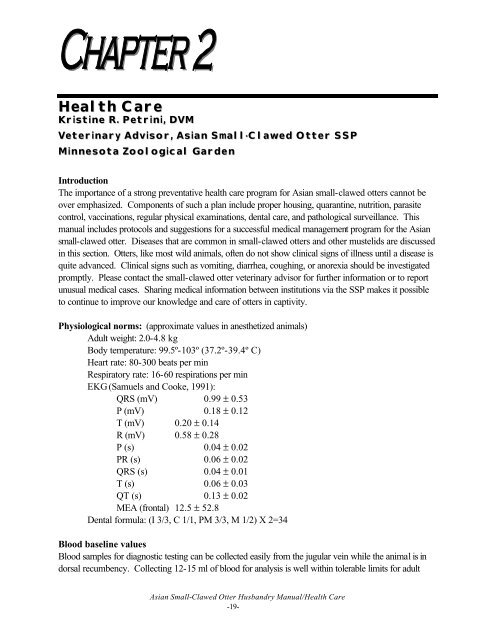Asian Small-Clawed Otter Husbandry Manual (1998)
Asian Small-Clawed Otter Husbandry Manual (1998)
Asian Small-Clawed Otter Husbandry Manual (1998)
You also want an ePaper? Increase the reach of your titles
YUMPU automatically turns print PDFs into web optimized ePapers that Google loves.
Health CareKristine R. Petrini, DVMVeterinary Advisor, <strong>Asian</strong> <strong>Small</strong>-<strong>Clawed</strong> <strong>Otter</strong> SSPMinnesota Zoological GardenIntroductionThe importance of a strong preventative health care program for <strong>Asian</strong> small-clawed otters cannot beover emphasized. Components of such a plan include proper housing, quarantine, nutrition, parasitecontrol, vaccinations, regular physical examinations, dental care, and pathological surveillance. Thismanual includes protocols and suggestions for a successful medical management program for the <strong>Asian</strong>small-clawed otter. Diseases that are common in small-clawed otters and other mustelids are discussedin this section. <strong>Otter</strong>s, like most wild animals, often do not show clinical signs of illness until a disease isquite advanced. Clinical signs such as vomiting, diarrhea, coughing, or anorexia should be investigatedpromptly. Please contact the small-clawed otter veterinary advisor for further information or to reportunusual medical cases. Sharing medical information between institutions via the SSP makes it possibleto continue to improve our knowledge and care of otters in captivity.Physiological norms: (approximate values in anesthetized animals)Adult weight: 2.0-4.8 kgBody temperature: 99.5º-103º (37.2º-39.4º C)Heart rate: 80-300 beats per minRespiratory rate: 16-60 respirations per minEKG (Samuels and Cooke, 1991):QRS (mV) 0.99 ± 0.53P (mV) 0.18 ± 0.12T (mV) 0.20 ± 0.14R (mV) 0.58 ± 0.28P (s) 0.04 ± 0.02PR (s) 0.06 ± 0.02QRS (s) 0.04 ± 0.01T (s) 0.06 ± 0.03QT (s) 0.13 ± 0.02MEA (frontal) 12.5 ± 52.8Dental formula: (I 3/3, C 1/1, PM 3/3, M 1/2) X 2=34Blood baseline valuesBlood samples for diagnostic testing can be collected easily from the jugular vein while the animal is indorsal recumbency. Collecting 12-15 ml of blood for analysis is well within tolerable limits for adult<strong>Asian</strong> <strong>Small</strong>-<strong>Clawed</strong> <strong>Otter</strong> <strong>Husbandry</strong> <strong>Manual</strong>/Health Care-19-
















